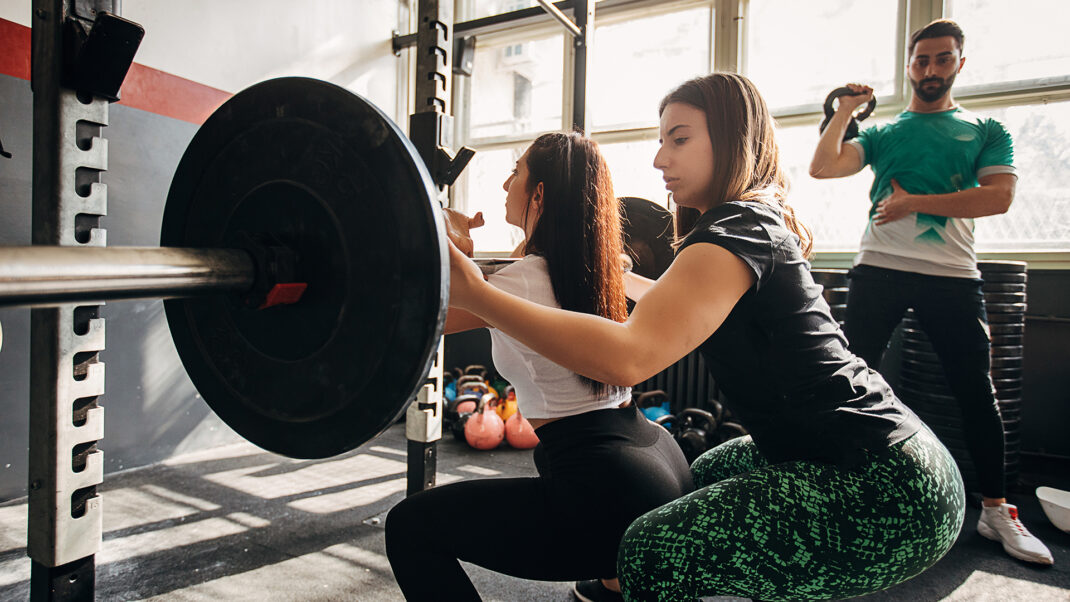The Knee Joint
Knee Joint Anatomy, Common Injuries and Postrehab Strategies.
Knee injuries are among the most common complaints of individuals involved in sports and fitness activities. This is not surprising, since the knee is a weight-bearing joint that must withstand large forces—sometimes, as in running and jumping, double and quadruple an individual’s body weight. This article will look at the anatomy of the knee, some common injuries, treatments typically used by healthcare professionals, and postrehabilitation strategies that personal fitness trainers (PFTs) can implement in their training programs.
Knee Joint Anatomy
The knee joint functions as a stabilizer for the lower extremity during weight bearing and allows large range of motion for various functional activities. The two primary articulations of the knee joint are the tibiofemoral joint and the patellofemoral joint.
The Tibiofemoral Joint
The tibiofemoral joint moves in the sagittal plane to flex and extend, and in the transverse plane to rotate when the knee is bent.
The following structures help stabilize the tibiofemoral joint:
Ligaments. Ligaments connect bones to other bones and prevent excessive movement and dislocation. The medial collateral ligament, lateral collateral ligament, anterior cruciate ligament and posterior cruciate ligament all support and stabilize the tibiofemoral joint. The iliotibial band (ITB) also helps support the knee to limit internal rotation of the tibia on the femur.
Menisci. The lateral and medial menisci add depth to the joint surface, thereby aiding in stability. They also serve to distribute load more evenly across the joint surfaces.
Joint Capsule. This capsule encloses the tibiofemoral and patellofemoral joints to increase stability.
The Patellofemoral Joint
The patellofemoral joint slides superiorly (up) when the knee extends and inferiorly (down) when the knee flexes. A slight amount of medial and lateral deviation, as well as tilting, takes place during normal movement.
The following structures help stabilize the patellofemoral joint.
Lateral Femoral Condyle. This rounded aspect of the distal end of the femur acts as a bony block to limit lateral motion during knee flexion.
Retinacular Tissue. This tissue, which is found medially and laterally, statically stabilizes the patella.
Muscles
The following muscles all act at the knee joint to flex, extend and rotate the knee:
Extensors: quadriceps femoris (rectus femoris, vastus medialis, vastus lateralis and vastus intermedius); tensor fasciae latae.
Flexors: hamstrings (biceps femoris, semitendinosus and semimembranosus); popliteus; gracilis; sartorius.
Internal (Medial) Rotators: semimembranosus; popliteus; pes anserinus (semitendinosus, gracilis, sartorius).
External (Lateral) Rotators: biceps femoris (possibly aided by the tensor fasciae latae as the knee moves into flexion).
Patellofemoral Pain Syndrome
One common knee injury is patello-femoral pain syndrome (PFPS). Clients may complain of symptoms when the knee is bent—for example, with stair climbing, squatting and sitting. A healthcare professional will take a clinical history and perform a physical exam to determine the cause of the pain or dysfunction, which may result from proximal or distal factors.
Proximal Factors
Patellar Position. The patella sits too high (patella alta) or too low (patella baja) anatomically.
Muscle Imbalance. The ratio of the vastus lateralis to the vastus medialis is imbalanced, resulting in increased lateral gliding with patella movement. Rather than moving up during knee extension, the patella moves out to the side and rubs on the femoral condyle.
Soft-Tissue Constraints. Distal ITB tightness results in lateral pulling of the patella.
Distal Factors
Increased Pronation and Rigid Cavus Foot. Poor foot posture and/or a rigid high arch of the foot can result in changes in the kinetic chain of the lower extremity.
Medical Treatment
The treatment chosen by the physician, physical therapist or athletic trainer depends on the cause of the PFPS. Orthotics may be prescribed to address a biomechanical foot dysfunction, or pain may be resolved by strengthening the vastus medialis and stretching the shortened ITB and hamstrings.
Postrehab Strategies
Once a medical professional has determined that the patient is ready for postrehab, a PFT can implement the following program:
Strengthening. Strength training should focus primarily on the vastus medialis. Potential exercises include the following:
- Leg presses with medicine ball (3 sets, 10–12 reps): Place 4- to 8-pound medicine ball between distal inner thighs and squeeze ball while extending knees.
- Isometric hip adduction (3 sets, 12–15 reps): Sit on one side, propped up on elbow, with top leg crossing over bottom leg and top foot planted in front of body. Flex bottom foot, tighten quadriceps, and lift bottom leg off floor 12–18 inches. Hold 7 seconds before lowering. An ankle weight can be added when more resistance can be tolerated while maintaining proper form.
- Lateral step-downs (3 sets, 10–12 reps): Stand on one leg on 6- to 10-inch step. Keeping hips level, lower unsupported leg just short of floor surface by bending support leg’s knee. Push through heel of support leg to rise back to starting position.
Flexibility. Hamstring tightness can contribute to PFPS, as can inflexibility of the gastrocnemius–soleus complex. In addition, ITB tightness can cause lateral tracking of the patella. Hence the client should perform flexibility exercises for all these areas.
Endurance. Low-impact exercise, such as bicycling and swimming, is most often suggested. For biking, the seat position should be high—approximately 15 degrees—to minimize patellofemoral joint reaction force (Farrell, Reisinger & Tillman 2003). As always, symptoms should never be provoked during exercise.
Functional Training. Perform agility drills, progressing from sport-specific straight-line drills to multidirectional activities, and emphasizing good vastus medialis control and recruitment. The key to progression is the absence of patellofemoral symptoms; all exercises should be pain free.
Rules of Thumb:
- Clients who experience recurring pain in the anterior aspect of the knee should be referred back to their healthcare professional.
- High-impact cardiovascular exercise, such as running or stair stepping, can provoke this injury; it is important to progress these modes of exercise slowly and conservatively and watch for a return of symptoms.
- Clients who are runners should include nonimpact cross-training in their program.
- Prolonged knee bending should be avoided. For example, for upper-body weight lifting, alternate between seated and standing exercises.
- Deep squats, which increase patello-femoral joint force, should be avoided.
Acute Jumper’s Knee
Individuals with this diagnosis may complain of symptoms with jumping. Jumper’s knee was first described in the early 1970s as tendinitis of the patellar tendon or quadriceps tendon at the inferior or superior aspect of the patella, respectively (Blazina et al. 1973). This definition was later expanded to include pathologic conditions at the bone-tendon junction at the tibial tuberosity. However, patellar tendinitis—the most frequent tendinitis of the knee—is localized at the lower portion of the patella.
Repetitive microtrauma results from the frequent use of the extensor mechanism in certain sports, such as volleyball, basketball, high jumping, long jumping and soccer.
Medical Treatment
Generally, individuals in the symptomatic phase start with open-chain exercises and stretching and then, if they are pain free, progress through closed-chain exercises before moving on to a postrehab program.
The area is sometimes taped. Alternatively, a patellar air cast or band may be indicated.
Postrehab Strategies
Warm-Up. With this condition, a warm-up of at least 5 minutes is especially important to get blood flowing to the patella tendon before exercising. Possible modalities include biking, upper-body ergometer exercise and brisk walking.
Stretching. Perform flexibility exercises for the quadriceps, hamstrings, ad-ductors, calf and ITB.
Concentric/Eccentric Quadriceps Ex-ercises (2– 4 seconds). Perform the following:
- Lateral step-downs (3 sets, 10–12 reps).
- Partial squats, progressing to single-leg squats and then to squats on an uneven surface such as a Dyna Disc™, foam board or wobble board (3 sets, 10–12 reps, 4-second lowering).
- Clocks (5 rotations, 4-second lowering): Stand on one leg on 6- to 10-inch step. Without dropping hip, lower unsupported leg to 12 o’clock position (forward) just short of floor surface by bending support leg’s knee. Push through heel of support leg to rise back to starting position. Next lower to a 1 o’clock position. Repeat for 2, 3, 4, 5 and 6 o’clock; then reverse the order.
Rules of Thumb:
- Reduce frequency of training if symptoms arise.
- Perform lower-extremity exercises on soft, flat terrain or surface.
- Wear proper footwear (including orthotics if applicable) for the activity and foot posture.
- Stretch before and after the activity.
- Follow a hard training or running day with an easy day.
Medial Collateral Ligament (MCL) Sprain
Individuals with this diagnosis may complain of symptoms of instability. The MCL is a broad band that runs from the medial epicondyle of the femur to insert on the tibia. It helps prevent outward movement of the lower leg at the knee.
A ligament can become injured when the normal range of motion is exceeded. In the example of the MCL, a valgus stress may be applied to the knee—for example, by a lateral blow—overstretching the ligaments on the medial side.
Medical Treatment
Generally, MCL injuries are treated nonoperatively. Measures are taken to reduce swelling and discomfort. Depending on the severity of the injury, treatment may also include bracing. Severity is based on a 3-grade scale, from grade 1 for a minor injury to grade 3 for a complete tear of the ligament.
Postrehab Strategies
Proprioception. PFTs can use touch to increase clients’ proprioception—that is, their awareness of joint motion (kinesthesia) and position. This awareness is important for providing smooth, coordinated movement, as well as protecting and dynamically stabilizing the knee.
- Single-Leg Stance on a Half-Foam Rol-ler (30 seconds to 1 minute, 3–5 reps): Client stands on half-foam roller—on both feet until he or she shows good tolerance, then on one foot. Meanwhile, PFT administers gentle to moderate tapping—forward, backward and side to side—on client’s shoulders. (Tapping shoulders puts client off balance, so knee must work harder to stabilize.) Dyna Disc, thick mat or wobble board can be used instead of foam roller.
Strengthening. Focus on the quadriceps, emphasizing dynamic stability and proprioception. Perform 3 sets of 10–12 reps of each of the following:
- Single cross-legged squats: Standing on one leg with opposite ankle crossed over standing leg’s thigh, lower thigh of unsupported leg toward parallel to floor by bending knee of supported leg. Hold onto stable surface as needed.
- Knee extension.
- Stair climbing or step-ups.
Endurance. Stationary biking is recommended to improve muscular and cardiovascular endurance.
Plyometrics. Emphasize the landing, softly accepting body weight on the foot/feet with bent knee(s). Perform 2–3 reps of each of the following exercises, for 20–60 seconds each:
- Lateral hops.
- Forward/backward hops.
- Single-leg hops.
- Rope skipping.
Agility. The following exercises increase dynamic stability of the ankle, knee and hip complexes. Perform 3–5 reps for a distance of 40–100 yards.
- Bounding runs (knees high).
- Figure-eight running.
Rules of Thumb:
- Avoid sudden increases in intensity.
- Wear comfortable, supportive shoes that fit the feet and activity.
- Progress to dynamic stability training only after client demonstrates painless unidirectional exercises in good form.
- Initially, avoid exercising with cleated shoes in muddy terrain, which could provoke valgus injury.
Red Flags
Always refer back to the client’s physician if one of these situations occurs:
* Pain or swelling arises.
* The client cannot bear weight on the lower extremities.
* The client feels as if the knee will buckle or give out.
References
Brotzman, S.B. 1996. Handbook of Orthopaedic Rehabilitation. St. Louis: Mosby, 193–258.
Farrell, K.C., Reisinger, K.D., & Tillman, M.D. 2003. Force and repetition in cycling: Possible implications for iliotibial band friction syndrome. Knee, 10 (1), 103–9.
Witvrouw, E., et al. 2002. Which factors predict outcome in the treatment program of anterior knee pain? Scandinavian Journal of Medicine and Science in Sports, 12, 40–46.





